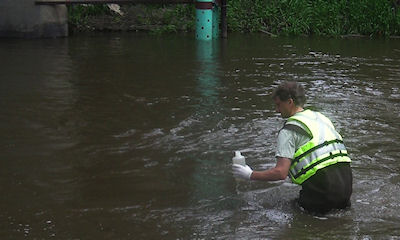August 18, 2015

In the first national-scale investigation of neonicotinoids in streams, the U.S. Geological Survey found that in more than half of urban and agricultural streams sampled, the pesticide could be detected.
Related: Neonic Pesticides Showing Up in Midwestern Streams, USGS Finds
The study, conducted from 2011 to 2014, is published in Environmental Chemistry. It spanned 24 states and Puerto Rico and was completed as part of ongoing USGS stream sampling.
"In the study, neonicotinoids occurred throughout the year in urban streams while pulses of neonicotinoids were typical in agricultural streams during crop planting season," said USGS research chemist Michelle Hladik, the report's lead author.

A USGS scientist collects water samples from a stream in Iowa following a recent rain event for the analysis of neonicotinoid insecticides. Photo credit: Laura Hubbard, USGS.
"The occurrence of low levels in streams throughout the year supports the need for future research on the potential impacts of neonicotinoids on aquatic life and terrestrial animals that rely on aquatic life," said USGS scientist Kathryn Kuivila, the research team leader. "These results will serve as an important baseline for that future work."
The study is the first step in setting priorities for exposure experiments and identifying adverse effects to animals and wildlife near or in streams.
Agriculture groups and others have been monitoring discussion about neonicotinoids' effects on non-target insects, especially pollinating honey bees and native bees.
Related: 'Bee-safe' Biopesticide Could Be Neonicotinoid Alternative
In May, the White House released the Strategy to Promote the Health of Honey Bees and Other Pollinators, which includes a Pollinator Research Action Plan.
"This research will support the overall goals of the Strategy, by helping to understand whether these water-borne pesticides, particularly at the low levels shown in this study, pose a risk for pollinators," said Mike Focazio, program coordinator for the USGS Toxic Substances Hydrology Program.
~~~PAGE_BREAK_HERE~~~
What researchers found
At least one of the six neonicotinoids tested by USGS researchers was found in more than half of the sampled streams.
No concentrations, however, exceeded the United States Environmental Protection Agency's aquatic life criteria, and all detected neonicotinoids are classified as not likely to be carcinogenic to humans.
Detections of the six neonicotinoids varied: Imidicloprid was found in 37% of the samples in the national study, clothianidin in 24%, thiamethoxam in 21%, dinotefuran in 13%, acetamiprid in 3%, and thiacloprid was not detected.
USGS says neonicotinoids use has been increasing over the past decade, especially on corn and soybeans. Much of this increase is due to a shift from leaf applications to using the insecticides prophylactically on seeds.
See more on the study on the USGS website.
You May Also Like




